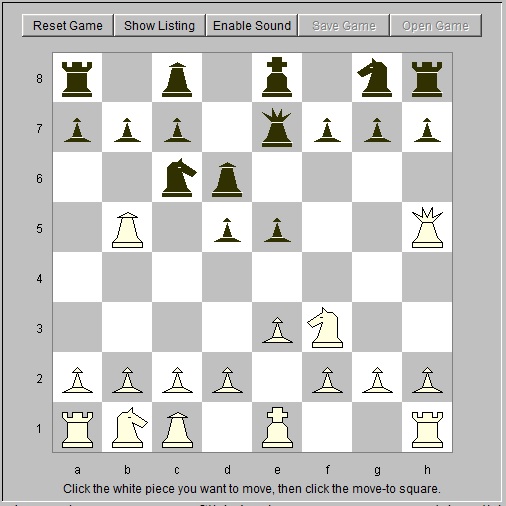
Position after move 5.
White Black 1. e3 e5 2. Qh5 Nc6 Black intends to punish this premature sortie by white's queen. 3. Bc4 d5 The attack on black's king is easily repulsed. 4. Bb5 Bd6 White switches the attack to black's king pawn. 5. Nf3 Qe7

6. Nc3 Nf6 Black has held against the all-out attack! White is out of ammo. 7. Qg5 Bd7 Offering a pseudo-sacrifice of a pawn. 8. Nh4 h6 Now the sacrifice is a real offering! 9. Qxg7 O-O-O Black's point: castle queenside and use the knight file for attack. 10. Qg3 Rd8g8 White saves his queen.
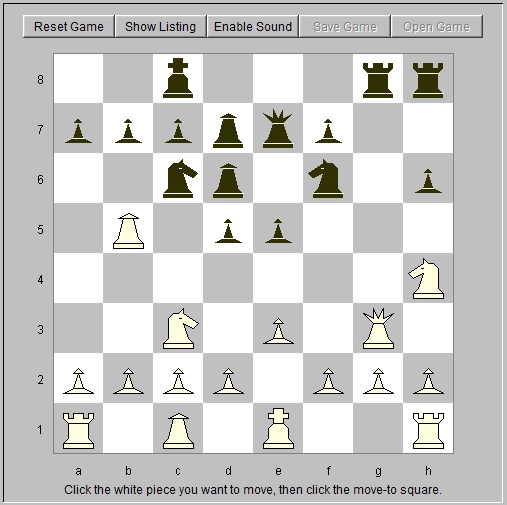
11. Qf3 e4 Black now controls the center, an ideal situation for an attack. 12. Qe2 Ng4 Exposing attack on the white knight. 13. g3 Be6 Black shifts the field and sacrifices a pawn on the queen side. 14. Bxc6 bxc6 15. Qa6+ Kd7 The king is perfectly safe. White's queen is drawn off in the pawn hunt.
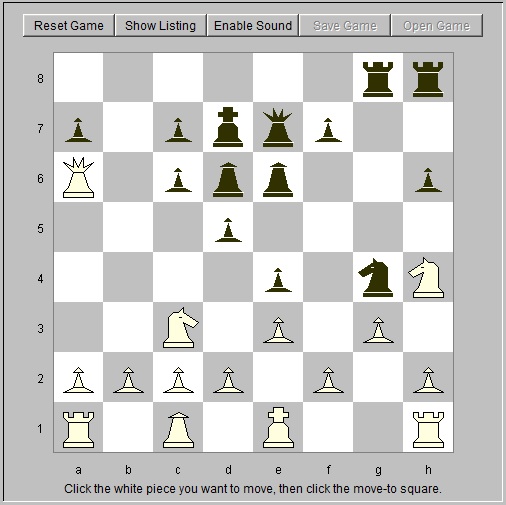
16. Nd1 Qf6 White anticipates black's attack on the king's bishop pawn. 17. Qxa7 Ne5 White takes the "free" pawn. 18. Qd4 Nf3+ 19. Nxf3 Qxf3 Black has eliminated the knight defender. 20. Rg1 c5 Black drives out the white queen.

21. Qa4+ Ke7 22. Nc3 h5 23. h4 Rxg3 White is helpess against the onslaught. 24. fxg3 Bxg3+ 25. Rxg3 Qxg3+

26. Kf1 Bh3+ 27. Ke2 Qf3+ White resigns
White Black 1. e4 e5 2. Nf3 Nc6 3. Nc3 Nf6 The Four Knights Game, known for 500 years. 4. Bc4 Nxe4 Black's move taking the pawn is the innovation. It's not listed in Horowitz's opening book. 5. Nxe4 d5 There doesn't seem to be a refutation. Alternatives to taking the knight fare poorly.

6. Bd3 dxe4 Other possibilities for white include Bb5 as well as Bxf7. 7. Bxe4 Bd6 This move is probably best for black. 8. O-O f5 Castling is probably best here. White needs to get castled anyway in other continuations. 9. Bxc6+ bxc6 Avoiding giving up the minor exchange lets black have an easy game. 10. Re1 e4
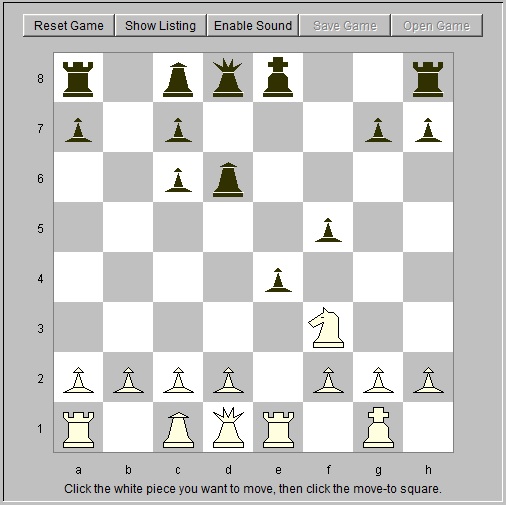
11. d3 Be7 White's d3 is solid but leads to no clear advantage for white. 12. Ne5 Qd6 Black's only move to save the pawn and prevent Qh5+. 13. Bf4 O-O Moves other than Bf4 lose the initiative. 14. dxe4 fxe4 The pawns must be exchanged sooner or later. 15. Bg3 Bf5 Black's Bf5 holds everything.
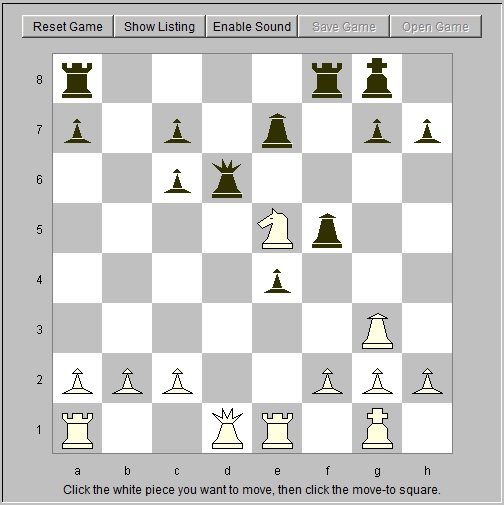
16. Qe2 Qc5 White needs to keep the queens on the board if he hopes to take advantage of black's somewhat exposed king. 17. c3 Bd6 18. Nc4 Bxg3 This bishop exchange seems unavoidable. 19. h2xg3 Ra8b8 20. Ra1d1 Be6 White hopes to make use of the open queen file, but black can close it off at will.
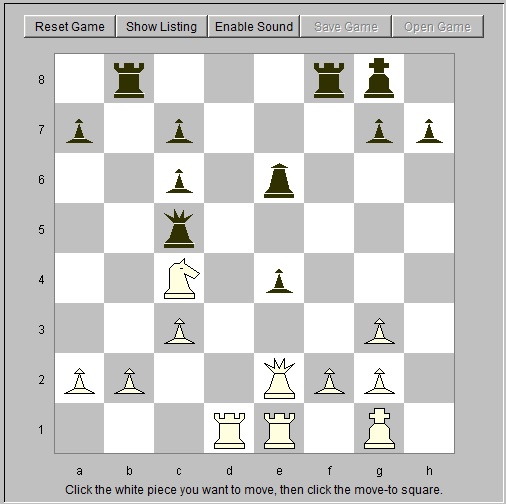
21. b3 Bf5 Black has the minor exchange (bishop against a knight), but his pawns are a mess. 22. Rd4 g5 Exposing the black king even more, but white is unable to capitalize on it. 23. Re1d1 h6 24. Qd2 Qb5 25. Ne3 c5? White wins a pawn.
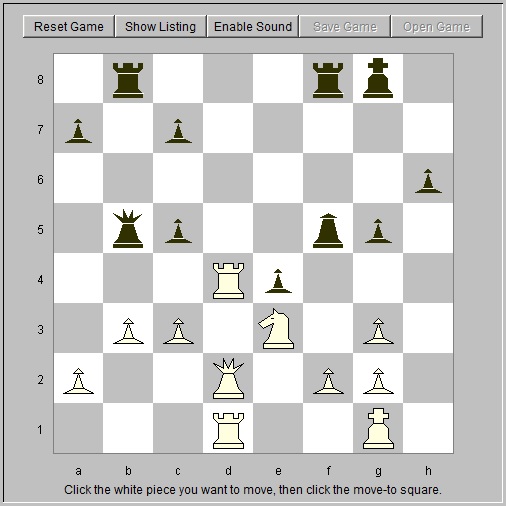
26. Ra4 Be6 27. Rxa7 Qc6 28. Qc2 Ra8 29. Rxa8 Rxa8 30. c4 Bd7 White's a pawn up now but it's a long hard slog to the end. 31. Nd5 Re8 32. Re1 Bf5 33. Qc3 Kf7 34. Qe3 Qd6 35. Rd1 Bg4 36. Rd2 Qc6 37. Nc3 Re5 38. Rd5 Rxd5 39. Nxd5 Bf5 40. Nc3 Kf6 41. Na4 Qa6 42. Qxc5 Qd6 43. Qxd6+ cxd6 44. Kf1 Bg4 45. Ke1 Kf7 46. Kd2 Bf5 47. Ke3 Kf6 48. Nc3 Ke5 49. a4 h5 50. a5 h4 51. gxh4 gxh4 52. a6 Bc8 53. a7 Bb7 54. Nd5 Bc6 55. Nc7 Kf6 56. a8=Q Bxa8 57. Nxa8 Ke5 58. Nc7 Kf5 59. Nb5 Ke5 60. b4 d5 61. cxd5 Kxd5 62. Nc3+ Kc4 63. b5 Kc5 64. Kxe4 Kb6 65. f4 Kc5 66. f5 Kd6 67. Nd5 h3 68. gxh3 Kc5 69. b6 Kc6 70. f6 Kd6 71. h4 Kc6 72. h5 Kb7 73. h6 Ka6 74. h7 Kb5 75. f7 Kc4 76. b7 Kb3 77. b8=Q+ Kc2 78. f8=Q Kd2 79. h8=R Black resigns
 Email Richard dot J dot Wagner at gmail dot com
Email Richard dot J dot Wagner at gmail dot com
chess.html, this hand crafted HTML file was created July 16, 2016.
Last updated August 1, 2016 by
Rick Wagner. Copyright © 2016, all rights reserved.